Research has indicated that maximizing corn yield potential in continuous corn production systems is challenging compared to systems with crop rotation.1 A six-year study by the University of Illinois documented a continuous corn yield penalty of 9 to 42 bushels per acre when compared to corn following soybeans. The yield of the continuous corn system decreased year over year for the length of this study. This was attributed to multiple factors including nitrogen (N) availability, corn crop residue accumulation, and weather conditions.1
Management
Fields selected for continuous corn should have soils with good drainage, high water holding capacity, high fertility, little to no compaction problems, and low insect and disease pressure.1
Residue. Healthy, high-yielding corn can result in increased levels of residue that can hinder emergence, seedling establishment, standability, and even yield potential of the next crop. Accumulated corn residues can reduce soil temperatures, reduce N availability, increase soil moisture, and favor the survival of specific insects and diseases. Appropriate residue management at harvest and at planting is key to successful continuous corn production (Figure 1). To help overcome residue challenges, farmers may need to use intense tillage or strip-tillage to aid in the breakdown and incorporation of residue. Combine attachments such as stalk chopping corn heads or straw choppers, or post-harvest shredding can be used to help size and spread residue uniformly. The rate of residue decomposition is influenced by soil temperature, moisture, microbial populations, and N to support microbial degradation of residue. Using strip-tillage and row cleaners at planting may facilitate better seed-to-soil contact and allow soils to warm faster.
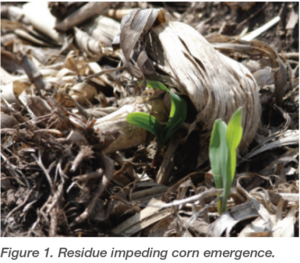
Fertility. Another hurdle in continuous corn production is the immobilization of N (N is tied up by microbes to decompose residue from the previous corn crop) (Figure 2).
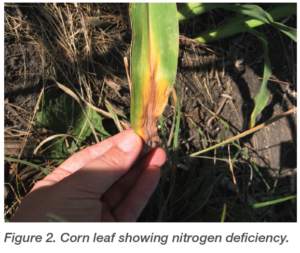
To overcome this when planting corn following corn, a higher N application rate is often recommended. An additional 30 to 50 pounds of N per acre may be required for continuous corn when compared to a corn-soybean rotation.2 The application of N at multiple times throughout the season, such as N applied preplant and as a side dress, may help increase N use efficiency by corn plants in a continuous corn system.
Phosphorus (P) and potassium (K) should also be maintained at optimum levels in continuous corn to encourage stand establishment and help minimize problems with stalk strength and stalk rots. Compared to soybean plants, corn plants use more P and less K. Using a balanced starter fertilizer is more likely to produce a positive response in continuous corn than in a corn-soybean rotation because of the stressful early growing conditions.
Product Selection. Another key for successful continuous corn production is selecting a well adapted corn product. Products should be selected with strong characteristic ratings for emergence, seedling vigor, disease resistance, and root and stalk strength. Products with higher emergence and seedling vigor ratings have a better chance of pushing through heavy residue, particularly when the residue is keeping soils cool and moist. Prior year residue can harbor pathogens for diseases such as northern corn leaf blight (Figure 3), gray leaf spot (Figure 4), Goss’s wilt (Figure 5) and Diplodia stalk rot (Figure 6); therefore, higher tolerance or resistance to these and other diseases is beneficial for continuous corn production. The likelihood of feeding by certain insect pests during the growing season, such as corn rootworms, is higher with continuous corn. To help protect against these insects, products with multiple modes of insect trait protection for above and below ground insects may be an option. When using these technologies, it is important to practice good stewardship. Corn rootworm is a serious pest and has overcome B.t. traits in some regions of the United States.
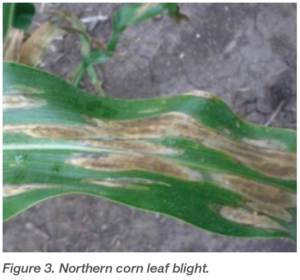
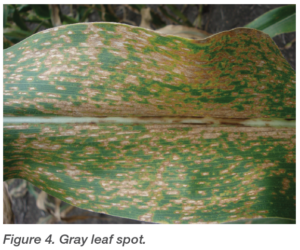
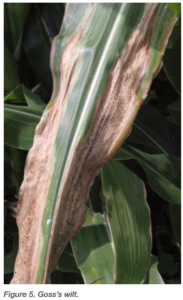
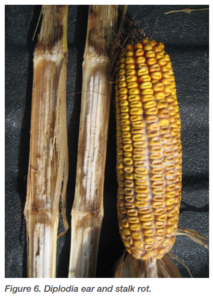
Seed Treatments. During seedling establishment, seed and seedling pathogens and soil insects, such as wireworms, seed corn maggots and grubs can be a threat, particularly when heavy residue is present. Appropriate seed treatments with fungicide and insecticide protection can help protect seeds and seedlings during emergence and early establishment.
Fungicides. Fungicides applied at VT to R2 growth stages may be beneficial if controllable leaf diseases have been observed during routine field scouting. Fields with heavier disease pressure may require a sequential fungicide program consisting of a pre-tassel application followed by a VT to R2 application. Fields should be scouted near tasselling to determine if a fungicide should be considered. Timely fungicide applications can be an important tool to help limit potential yield losses. Always read and follow fungicide labels.
Weed Control. Herbicide options are limited when planting corn after corn. Additionally, corn residue can reduce the efficacy of many soil-applied herbicides and/or shield young weed seedlings from contact herbicides. A soil-applied residual herbicide should be applied either preplant or preemergence to decrease weed pressure and reduce potential selection of herbicide-tolerant weeds. Providing early season weed control can widen the postemergence application window. For the most effective weed control, postemergence herbicide applications should be made when weeds are small. Control of volunteer corn is especially problematic in continuous corn systems. A proactive management approach is necessary because control options are limited after the new corn crop is established. At harvest, lodged plants, ear drop, improper combine adjustments, and poor harvest conditions can cause grain loss and increase the potential for volunteer corn the next spring. Keeping harvest losses to a minimum, and tilling fields in the fall are tools that can reduce volunteer corn in the following crop. Since herbicide options are limited, cultivation may be the best option for volunteer corn control in corn.
Planting. Unless all corn acres are continuous, consider planting corn on corn acres last because residue is likely to keep the soil wetter and cooler. Increasing seeding rates to offset emergence losses associated with seedling diseases and insects is generally not necessary. The chance of seedling losses may be higher in continuous corn; however, other management practices such as product selection and quality seed treatments may help reduce seedling establishment issues. Your Bayer representative can help identify the recommended seeding rate for each product. Because corn residue from the previous year may impede seed-to-soil contact, manage the seedbed to reduce residue interference and improve seed-to-soil contact for improved stand establishment.
